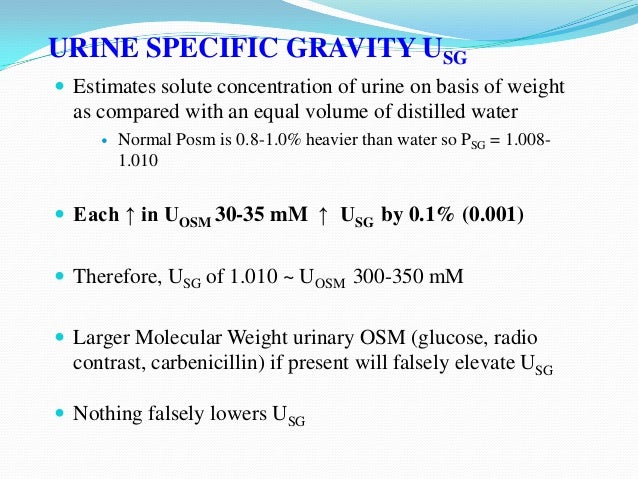

Urine analysis could also be potentially useful in hospital patients. The medical importance of chronic moderate dehydration has not been thoroughly investigated, whereas severe dehydration has undisputed effects on health by reducing physical and intellectual performance. This concentration process can be prevented by appropriate replacement of the body water lost during exercise. The loss of body water caused by physical activity causes the kidneys to conserve (retain) water, thereby raising the specific gravity of the urine, increasing the osmolality and the creatinine concentration, and causing darkening of the urine color.

One method developed in sports medicine is based on the concept that high urinary concentrations of metabolic waste products indicate dehydration.

Mayomedicallaboratories.Moderate dehydration is a difficult condition to detect in clinical medicine. With dehydration, the urine osmolality should be 3 to 4 times the plasma osmolality.” Mayo Clinic Lab The normal kidney can concentrate a urine to 800 to 1,400 mOsmol/kg and with excess fluid intake, a minimal osmolality of 40 to 80 mOsmol/kg can be obtained. Above the age of 20 years, there is an age-dependent decline in the upper reference range of approximately 5 mOsm/kg/year. With a normal fluid intake and normal diet, a patient will produce a urine of about 500 to 850 mOsmol/kg water. Normally, the ratio of urine osmolality to serum osmolality is 1.0 to 3.0, reflecting a wide range of urine osmolality. More information concerning the state of renal water handling or abnormalities of urine dilution or concentration can be obtained if urinary osmolality is compared to serum osmolality and if urine electrolyte studies are performed. The ability of the kidney to maintain both tonicity and water balance of the extracellular fluid can be evaluated by measuring the osmolality of the urine either routinely or under artificial conditions. Urinary osmolality corresponds to urine specific gravity in nondisease states. Urine osmolality is a measure of the concentration of osmotically active particles, principally sodium, chloride, potassium, and urea glucose can contribute significantly to the osmolality when present in substantial amounts in urine. “Osmolality is an index of the solute concentration. The Following is from the Mayo Clinic Lab. More on Urine Osmolality, From Mayo Clinic Lab A urine osmolality of > 700 suggests extra-renal water loss while a urine osmolality of < 700 suggests a renal water loss. Urine osmolality 700 due to a maximum ADH effect. This would suggest SIADH and other conditions where ADH is also high like glucocorticoid deficiency, hypothyroidism, and drugs. ADH which controls urine osmolality is not doing what it should be doing to raise the low serum osmolality. – Urinary osmolality > 100 mOsm/kg is considered inappropriately high. In the context of hypotonic hyponatremia (“true” hyponatremia), In the context of hyponatremia, an osmolality of 100 mOsm/kg is a cut off for osmolality that is usually used. Urine Osmolality in a Hyponatremic Patient Normal Range: 50-1200 mOsm/kg - Ferri’s Practical Guide. A urine osmolality > 100 mOsm/L in a euvolemic patient without any other issues is suggestive of SIADH. Urine Osmolality range: 50 mOsm/L (no ADH) to 1200 mOsm/L (maximum ADH).” Pocket Medicine “ Urine Osmolality is an indirect functional assay of the ADH-renal axis. Urine osmolality is useful for assessing the concentrating and diluting ability of the kidney.


 0 kommentar(er)
0 kommentar(er)
